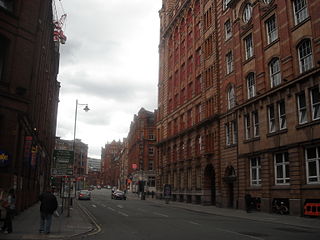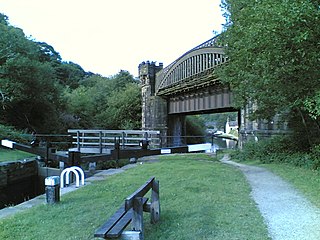Coordinates: 53°28′30″N2°14′06″W / 53.475°N 2.235°W

A geographic coordinate system is a coordinate system that enables every location on Earth to be specified by a set of numbers, letters or symbols. The coordinates are often chosen such that one of the numbers represents a vertical position and two or three of the numbers represent a horizontal position; alternatively, a geographic position may be expressed in a combined three-dimensional Cartesian vector. A common choice of coordinates is latitude, longitude and elevation. To specify a location on a plane requires a map projection.

Sackville Street is a street in Manchester city centre, England.

A street is a public thoroughfare in a built environment. It is a public parcel of land adjoining buildings in an urban context, on which people may freely assemble, interact, and move about. A street can be as simple as a level patch of dirt, but is more often paved with a hard, durable surface such as concrete, cobblestone or brick. Portions may also be smoothed with asphalt, embedded with rails, or otherwise prepared to accommodate non-pedestrian traffic.

Manchester city centre is the central business district of Manchester, England, within the boundaries of Trinity Way, Great Ancoats Street and Whitworth Street. The City Centre ward had a population of 17,861 at the 2011 census.
Sackville Street runs in a northwest-southeast direction and is split into two sections by Whitworth Street, which runs in a northeast-southwest direction. At the northern end of the street is a junction with Portland Street. The northern half of the street runs through Manchester's Gay Village and past Chorlton Street Coach Station. Here the street crosses Canal Street and is carried by a bridge over the Rochdale Canal and there is also a small public park, Sackville Gardens. Beyond Whitworth Street the southern half of the street runs through what was until 2004 the campus of the University of Manchester Institute of Science and Technology (UMIST), which is now part of the University of Manchester (the Sackville Street Campus). [1] Here the street crosses Granby Row and runs under a railway viaduct, which carries the line between Manchester's Piccadilly and Oxford Road railway stations. It then continues past Charles Street (right) to its southern end where there is a junction with the Mancunian Way (the A57). [2] The song 'Sackville' by Inspiral Carpets is about the street.

Whitworth Street is a street in Manchester, England. It runs between London Road (A6) and Oxford Street (A34). West of Oxford Street it becomes Whitworth Street West which then goes as far as Deansgate (A56). It was opened in 1899 and is lined with many large and grand warehouses. It is named after the engineer Joseph Whitworth whose works once stood along the route. Whitworth Street West runs alongside the viaduct connecting Oxford Road and Deansgate railway stations: beyond Albion Street the Rochdale Canal is on the northern side. On the Albion Street corner is the building once occupied by the Haçienda nightclub at nos. 11-13 while further east on the same side is the Ritz.

Portland Street is a popular street in Kowloon, Hong Kong. The street is known for its business and retailing skyscraper complex Langham Place, numerous restaurants and its red-light district.

Canal Street, the centre of the Manchester Gay Village, is a street in Manchester city centre in North West England. The pedestrianised street, which runs along the west side of the Rochdale Canal, is lined with gay bars and restaurants. At night time, and in daytime in the warmer months, the street is filled with visitors, often including gay and lesbian tourists from all over the world. The northern end of the street meets Minshull Street and the southern meets Princess Street; part of the street looks across the Rochdale Canal into Sackville Park.
An 1801 map shows Sackville Street extending no further than the Rochdale Canal and an 1844 railway plan indicates that the part of the road extending south of the canal was called ¨Zara Street¨. [3]

The Rochdale Canal is a navigable broad canal in Northern England, between Manchester and Sowerby Bridge, part of the connected system of the canals of Great Britain. Its name refers to the town of Rochdale, in Greater Manchester, through which it passes.
















